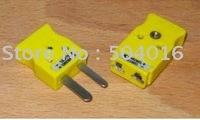
Originally Posted by
B92 8NW

I have a 6mm VDO thermocouple wired to a VDO pyro via the supplied 5m "compensating cable" (one wire is copper, the other is something else).
I've just bought an Auber exposed tip thermocouple which is suppled with 1.8m of cable. Obviously it advises not to change the length of the cable, but if put a K-type plug on the end and plug it into the VDO compensating loom will it be accurate?
As Drivesafe says, dissimilar metal junctions cause errors in thermocouple circuits. You can extend thermocouple cables (up to >100m in industrial situations in the past) using either the same thermocouple alloy wires or compensating extension cable which has the same thermoelectric properties over a limited temperature span.
Is the VDO cable you're considering the stuff with a redish-brown PVC sheath and red and brown covered wires? If so, it should be an international standard compensating cable for type K.
Are you planning on attaching the Auber probe to your existing VDO analog gauge? If so, I suggest you ensure the total length of cable from the probe to the gauge terminals is a close as possible to that of the original VDO sensor. Analog gauges such as this are low impedence devices and are calibrated not only to the thermoelectric characteristics of the thermocouple but also to allow for the total resistance of the sensor cable. Electronic thermocouple gauges are high impedence devices and are generally unaffected by cable resistance changes.
By the way, I wouldn't use the Auber exposed tip T/C in a pre-turbo (upstream) situation. I'd only ever use a fully sheathed T/C pre-turbo.
Ian
Ian &
Leo - SIII 109/GMH3.3
Daphne I - '97 Disco 300Tdi Manual
Daphne II - '03 Disco Td5 Auto



 Reply With Quote
Reply With Quote


Bookmarks